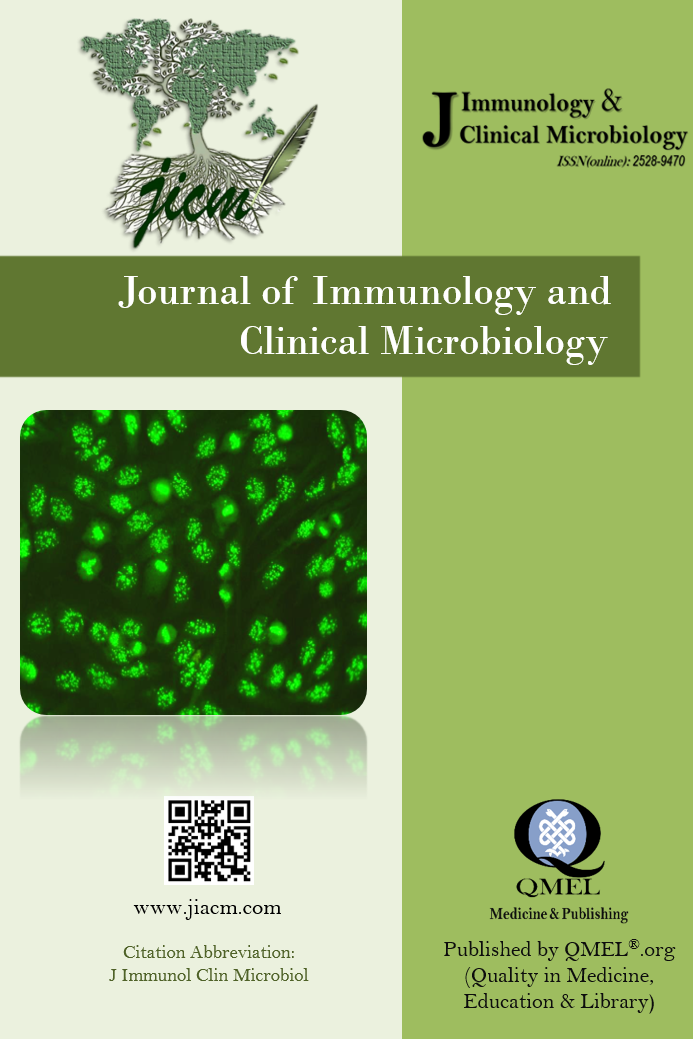Ethiological, Clinical and Epidemiological Overview of Covid-19 Pandemia
Ethiological, Clinical and Epidemiological Overview of Covid-19 Pandemia
Covid-19, Pandemia Coronaviruses,
___
- 1. Cascella M, Rajnik M, Cuomo A, Dulebohn SC, Di Napoli, R. Features, Evaluation and Treatment Coronavirus (COVID-19). 2020. Accessed July 4, 2020, from https://www.ncbi.nlm.nih.gov/books/NBK554776/
- 2. Republic of Turkey Ministry of Health, COVID-19 Guide. 2020. Accessed January, 2020, from https://hsgm.saglik.gov.tr/depo/haberler/ncov/2019Cov_Hastal_Salk_alanlar_Rehberi.pdf
- 3. Wu A, Peng Y, Huang B, Ding X, Wang X, Niu P, at al. Genome Composition and Divergence of the Novel Coronavirus (2019-nCoV) Originating in China. Cell Host & Microbe. 2020; 11; 27(3), 325–328. 4. Guo YR, Cao OD, Hong ZS, Tan YY, Chen SD, Jin HJ, at al. The origin, transmission and clinical therapies on coronavirus disease 2019 (COVID-19) outbreak – an update on the status. Mil Med Res. 2020; 13;7(1), 11.
- 5. Yoshimoto FK. The Proteins of Severe Acute Respiratory Syndrome Coronavirus 2 (SARS CoV 2 or n COV19), the Cause of COVID 19. The Protein Journal. 2020; 39, 198–216.
- 6. Lan J, Ge J, Yu J, Shan S, Zhou H, Fan S, at al. Structure of the SARS-CoV-2 spike receptor-binding domain bound to the ACE2 receptor. Nature. 2020; 5(1), 104.
- 7. Walls AC, Park YJ, Tortorici MA, Wall A, McGuire AT, Vessler D. Structure, function, and antigenicity of the SARSCoV-2 spike glycoprotein. Cell. 2020; 180, 281–292.
- 8. World Health Organization Scientific Brief. Modes of transmission of virus causing COVID-19: implications for IPC precaution recommendations. Accessed March 29, 2020, from https://www.who.int/news-room/commentaries/detail/modes-of-transmission-of-virus-causingcovid-19-implications-for-ipc-precaution-recommendations
- 9. World Health Organization Interim Guidance. COVID-19 and food safety: guidance for food businesses. Accessed April 7, 2020, from https://www. who. int/publications-detail/covid-19-andfood-safety-guidance-for-food-businesses
- 10. Cheng VCC, Lau SKP, Woo PCY, Kwok YY. Severe acute respiratory syndrome coronavirus as an agent of emerging and reemerging infection. Clin. Microbiol. Rev. 2007; 20(4), 660–694.
- 11. Mandavkar P. Coronavirus: Basic Information and Precautionary Measures. SSRN Electron. J. 2020. Accessed April 13, 2020, from https://dx.doi.org/10.2139/ssrn.3573881
- 12. Doremalen NV, Bushmaker T, Morris DH, Holbrook MG, Gambl A, Williamson BN, at al. Aerosol and Surface Stability of SARS-CoV-2 as Compared with SARS-CoV-1. N. Engl. J. Med.2020; 382(16), 1564-1567.
- 13. Kafetzopoulos DP, Psomas EL, Kafetzopoulos PD. Measuring the effectiveness of the HACCP Food Safety Management System. Food Control. 2013; 33: 2, 505–513. 14. Oudit GY, Kassiri Z, Jiang C, Liu PP, Poutanen SM, Penninger JM, at al. SARS-coronavirus modulation of myocardial ACE2 expression and inflammation in patients with SARS. Eur J Clin Invest. 2009; 39 (7), 618–625.
- 15. Fyhrquist F, Saijonmaa O. Renin-angiotensin system revisited. Journal of Internal Medicine. 2008; 264, 224–236.
- 16. Wang Q, Zhang Y, Wu L, Niu S, Song C, Zhang Z, at al. Structural and Functional Basis of SARS-CoV-2 Entry by Using Human ACE2. Cell. 2020; 181, 894–904.
- 17. Memikoğlu KO, Genç V. COVID-19. Ankara Üniversitesi Basımevi, 55-58. ISBN: 978- 605-136-477-3. Accessed November 11, 2020, from http://www.medicine.ankara.edu.tr/wp-content/uploads/sites/121/2020/05/COVID-19-Kitap.pdf
- 18. Zhang C, Wu Z, Li JW, Zhao H, Wang GQ. Cytokine release syndrome in severe COVID-19: interleukin-6 receptor antagonist tocilizumab may be the key to reduce mortality. International Journal of Antimicrobial Agents. 2020; 55, 105954.
- 19. World Health Organization Situation Report. Coronavirus disease 2019 (COVID-19) Situation Report – 73. Accessed April 2, 2020, from https://www.who.int/docs/default-source/coronaviruse/situationreports/20200402-sitrep-73-covid-19.pdf
- 20. Republic of Turkey Ministry of Health, COVID-19 Guide. 2020. Accessed Agust, 2020, from https://covid19bilgi.saglik.gov.tr/depo/rehberler/covid-19-rehberi/COVID19_REHBERI_ERISKIN_HASTA_TEDAVISI.pdf
- 21. World Health Organization. Report of the WHO-China Joint Missionon Coronavirus Disease. 2019 (COVID-19). Accessed February 20, 2020, from https://www.who.int/docs/defaultsource/coronaviruse/who-china-joint-mission-on-covid-19-finalreport.pdf#:~:text=Using%20available%20preliminary%20data%2C,severe%20or%20critical%20 disease
- 22. World Health Organization. Immunity passports" in the context of COVID-19. Scientific Brief. Accessed April 24, 2020, from https://www.who.int/news-room/commentaries/detail/immunitypassports-in-the-context-of-covid-19
- 23. Yoon SH, Lee KH, Kim JY, Lee YK, Ko H, Kim KH, at al. Chest Radiographic and CT Findings of the 2019 Novel Coronavirus Disease (COVID-19): Analysis of Nine Patients Treated in Korea. Korean J Radiol. 2020; 21(4), 494-500.
- 24. Guan CS, Wei LG, Xie RM, Lv ZB, Yan S, Zhang ZX, at al. CT findings of COVID-19 in follow-up: comparison between progression and recovery. Diagn Interv Radiol. 2020; 26, 301–307.
- 25. Ye Z, Zhang Y, Wang Y, Huang Z, Song B. Chest CT manifestations of new coronavirus disease 2019 (COVID-19): a pictorial review. European Society of Radiology. 2020; 30, 4381–4389.
- 26. Çinkooğlu A, Hepdurgun C, Bayraktaroğlu S, Ceylan N, Savaş R. CT imaging features of COVID-19 pneumonia: initial experience from Turkey. Diagn Interv Radiol. 2020; 26, 308–314.
- 27. Gezer NS, Ergan B, Barış MM, Apak Ö, Sayıner AA, Balcı P, at al. COVID-19 S: A new proposal for diagnosis and structured reporting of COVID-19 on computed tomography imaging. Diagn Interv Radiol. 2020; 26, 315–322.
- 28. World Health Organization. Coronavirus disease (COVID-19). Situation Report – 115. Accessed May 14, 2020, from https://www.who.int/docs/default-source/coronaviruse/situationreports/20200514-covid-19-sitrep-115.pdf?sfvrsn=3fce8d3c_6
- Yayın Aralığı: Yılda 4 Sayı
- Başlangıç: 2016
- Yayıncı: Erkan YULA
Two Elderly Patients with Disseminated Tuberculosis
Changes in Antibiotic Susceptibility of Urinary Tract Pathogens in Pediatric Population by Years
Romatoit Artrit Öntanılı Hasta Serumlarında Anti CCP ve RF ‘ün Değerlendirilmesi
Selçuk KAYA, Mehmet KARABEY, Ayşegül AKSOY GÖKMEN, Gökhan KABADAYI
COVİD-19 İLE İLİŞKİLİ KANDİDEMİ
Fatma Meral İNCE, Özge ALKAN BİLİK, Hasan İNCE
Osman ERSEGUN BATCİK, İlkay BAHÇECİ
Ethiological, Clinical and Epidemiological Overview of Covid-19 Pandemia
Cervical Lymphadenitis Mimicking Lymphoma: A Case of Tuberculosis
